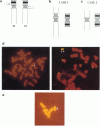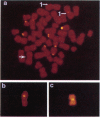Abstract
Fluorescence in situ hybridization with five biotin-labeled probes (three alphoid probes, a probe specific for beta-satellite sequences in all acrocentric chromosomes, and an rDNA probe) was used to characterize 30 different Robertsonian translocations, including three t(13;13); one t(15;15), four t(21;21), three t(13;14), two t(13;15), two (13;21), two t(13;22), one t(14;15), eight t(14;21), two t(14;22), and two t(21;22). Of 8 de novo homologous translocations, only one t(13;13) chromosome was interpreted as dicentric, while 19 of 22 nonhomologous Robertsonian translocations were dicentric. The three monocentric nonhomologous translocations included both of the t(13;21) and one t(21;22). Two of 26 translocations studied using the beta-satellite probe showed a positive signal, while rDNA was undetectable in 10 cases studied. These results indicate that most homologous Robertsonian translocations appear monocentric, while the bulk of nonhomologous translocations show two alphoid signals. A majority of the breakpoints localized using this analysis seem to be distal to the centromere and just proximal to the beta-satellite and nuclear-organizing regions.
Full text
PDF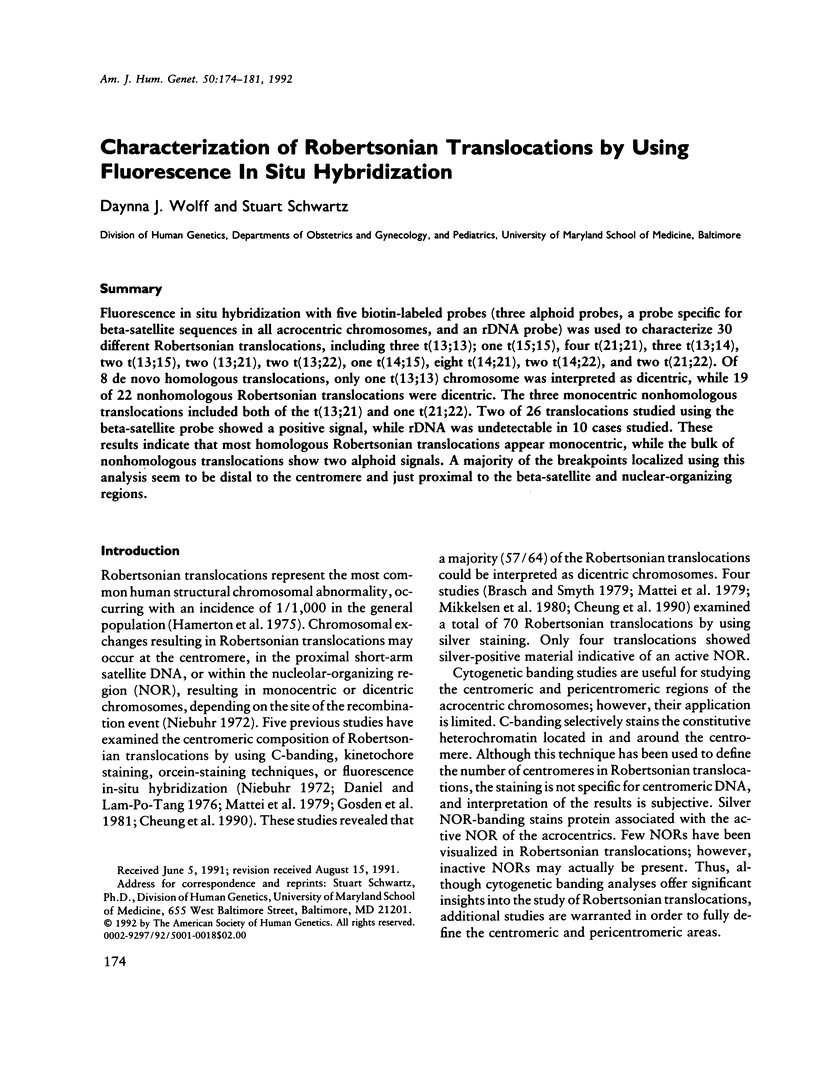
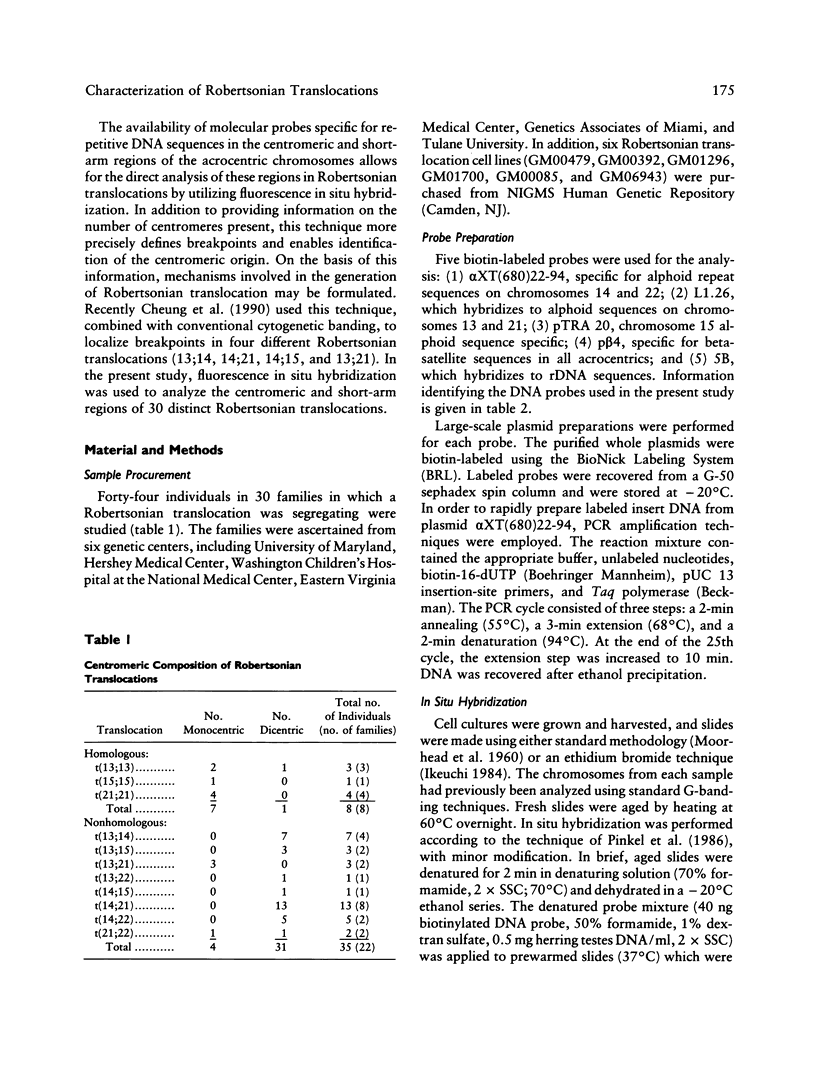

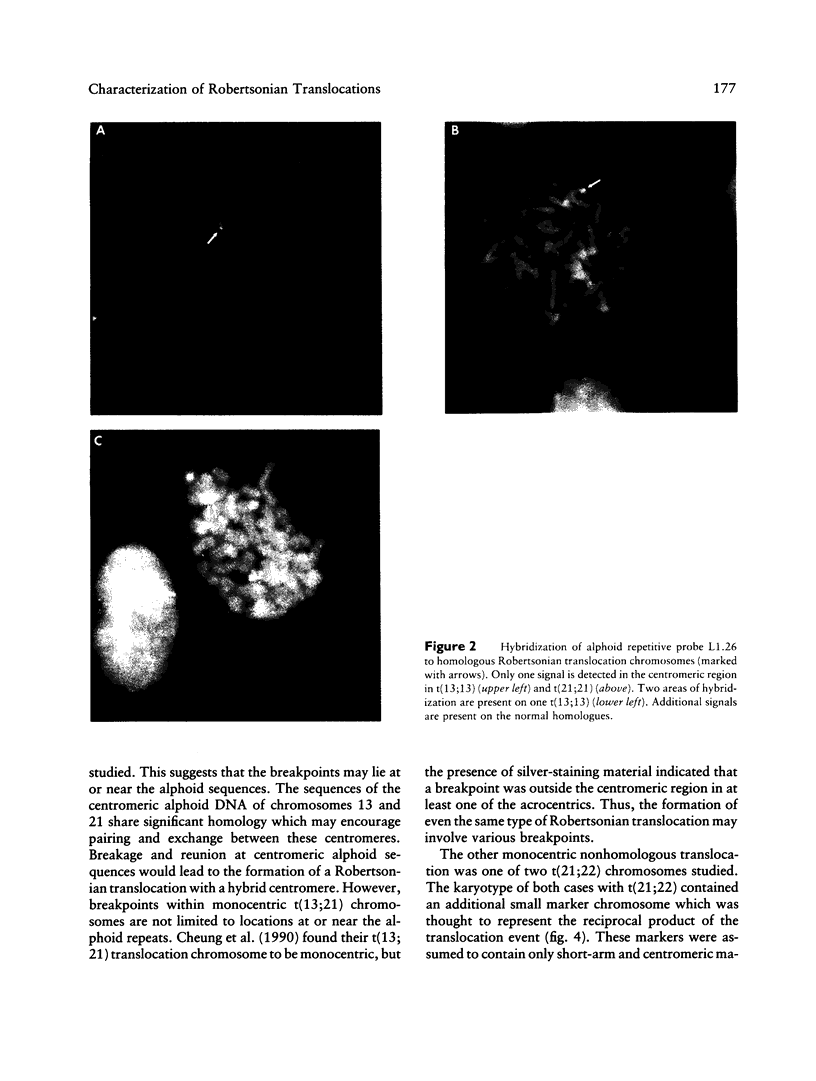

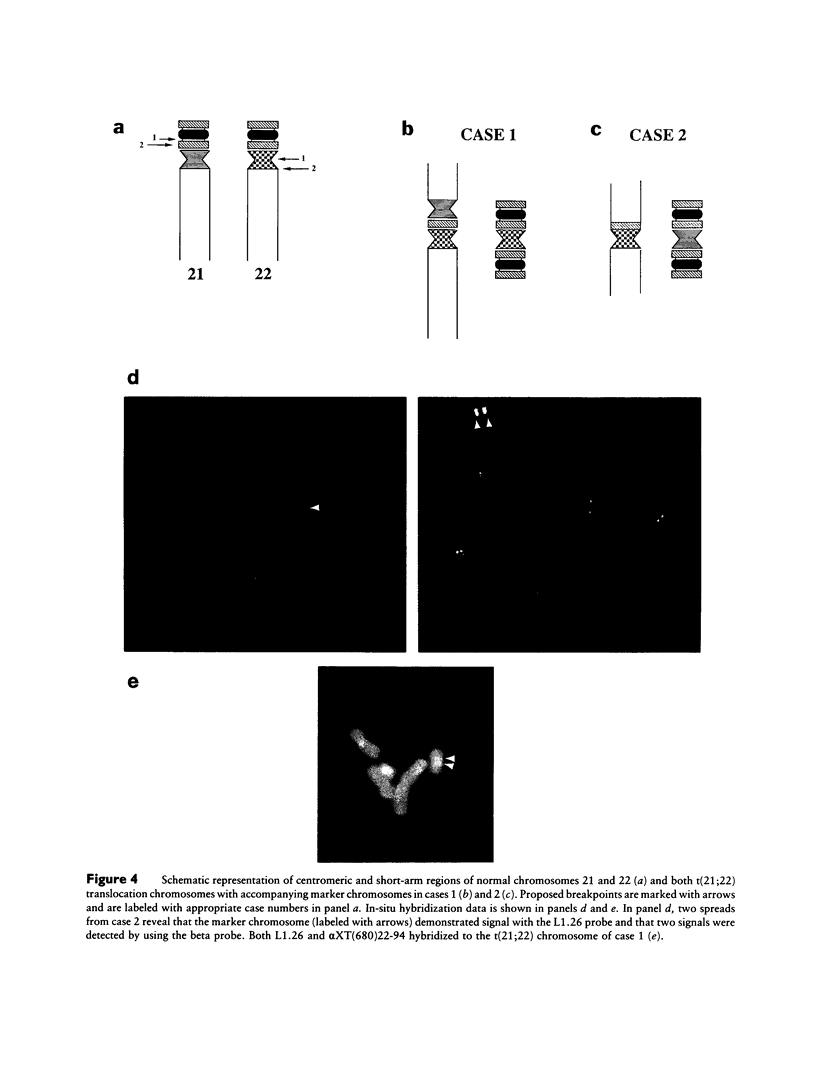
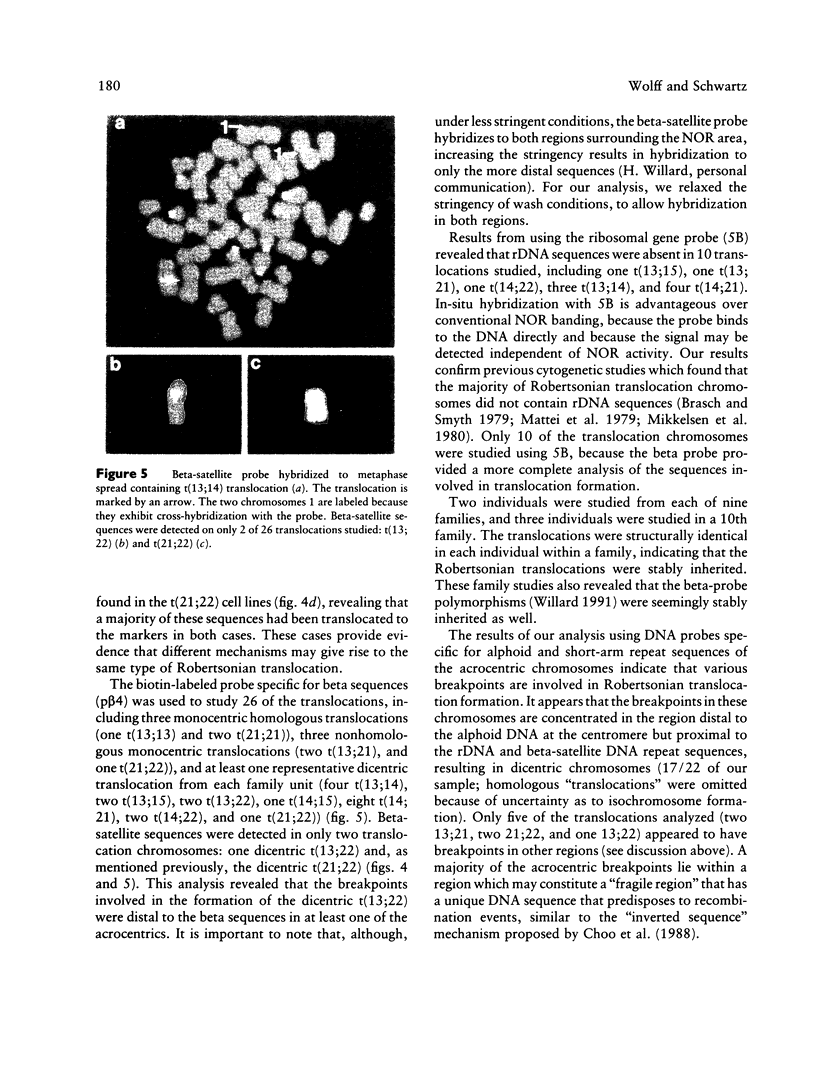

Images in this article
Selected References
These references are in PubMed. This may not be the complete list of references from this article.
- Antonarakis S. E., Adelsberger P. A., Petersen M. B., Binkert F., Schinzel A. A. Analysis of DNA polymorphisms suggests that most de novo dup(21q) chromosomes in patients with Down syndrome are isochromosomes and not translocations. Am J Hum Genet. 1990 Dec;47(6):968–972. [PMC free article] [PubMed] [Google Scholar]
- Bowman L. H., Rabin B., Schlessinger D. Multiple ribosomal RNA cleavage pathways in mammalian cells. Nucleic Acids Res. 1981 Oct 10;9(19):4951–4966. doi: 10.1093/nar/9.19.4951. [DOI] [PMC free article] [PubMed] [Google Scholar]
- Brasch J. M., Smyth D. R. Absence of silver bands in human Robertsonian translocation chromosomes. Cytogenet Cell Genet. 1979;24(2):122–125. doi: 10.1159/000131365. [DOI] [PubMed] [Google Scholar]
- Cheung S. W., Sun L., Featherstone T. Molecular cytogenetic evidence to characterize breakpoint regions in Robertsonian translocations. Cytogenet Cell Genet. 1990;54(3-4):97–102. doi: 10.1159/000132970. [DOI] [PubMed] [Google Scholar]
- Choo K. H., Earle E., Vissel B., Filby R. G. Identification of two distinct subfamilies of alpha satellite DNA that are highly specific for human chromosome 15. Genomics. 1990 Jun;7(2):143–151. doi: 10.1016/0888-7543(90)90534-2. [DOI] [PubMed] [Google Scholar]
- Choo K. H., Vissel B., Brown R., Filby R. G., Earle E. Homologous alpha satellite sequences on human acrocentric chromosomes with selectivity for chromosomes 13, 14 and 21: implications for recombination between nonhomologues and Robertsonian translocations. Nucleic Acids Res. 1988 Feb 25;16(4):1273–1284. doi: 10.1093/nar/16.4.1273. [DOI] [PMC free article] [PubMed] [Google Scholar]
- Daniel A., Lam-Po-Tang P. R. Structure and inheritance of some heterozygous Robertsonian translocation in man. J Med Genet. 1976 Oct;13(5):381–388. doi: 10.1136/jmg.13.5.381. [DOI] [PMC free article] [PubMed] [Google Scholar]
- Devilee P., Cremer T., Slagboom P., Bakker E., Scholl H. P., Hager H. D., Stevenson A. F., Cornelisse C. J., Pearson P. L. Two subsets of human alphoid repetitive DNA show distinct preferential localization in the pericentric regions of chromosomes 13, 18, and 21. Cytogenet Cell Genet. 1986;41(4):193–201. doi: 10.1159/000132229. [DOI] [PubMed] [Google Scholar]
- Gosden J. R., Lawrie S. S., Gosden C. M. Satellite DNA sequences in the human acrocentric chromosomes: information from translocations and heteromorphisms. Am J Hum Genet. 1981 Mar;33(2):243–251. [PMC free article] [PubMed] [Google Scholar]
- Grasso M., Giovannucci Uzielli M. L., Pierluigi M., Tavellini F., Perroni L., Dagna Bricarelli F. Isochromosome not translocation in trisomy 21q21q. Hum Genet. 1989 Dec;84(1):63–65. doi: 10.1007/BF00210673. [DOI] [PubMed] [Google Scholar]
- Hamerton J. L., Canning N., Ray M., Smith S. A cytogenetic survey of 14,069 newborn infants. I. Incidence of chromosome abnormalities. Clin Genet. 1975 Oct;8(4):223–243. doi: 10.1111/j.1399-0004.1975.tb01498.x. [DOI] [PubMed] [Google Scholar]
- Ikeuchi T. Inhibitory effect of ethidium bromide on mitotic chromosome condensation and its application to high-resolution chromosome banding. Cytogenet Cell Genet. 1984;38(1):56–61. doi: 10.1159/000132030. [DOI] [PubMed] [Google Scholar]
- Jørgensen A. L., Kølvraa S., Jones C., Bak A. L. A subfamily of alphoid repetitive DNA shared by the NOR-bearing human chromosomes 14 and 22. Genomics. 1988 Aug;3(2):100–109. doi: 10.1016/0888-7543(88)90139-5. [DOI] [PubMed] [Google Scholar]
- MOORHEAD P. S., NOWELL P. C., MELLMAN W. J., BATTIPS D. M., HUNGERFORD D. A. Chromosome preparations of leukocytes cultured from human peripheral blood. Exp Cell Res. 1960 Sep;20:613–616. doi: 10.1016/0014-4827(60)90138-5. [DOI] [PubMed] [Google Scholar]
- Mattei M. G., Mattei J. F., Ayme S., Giraud F. Dicentric Robertsonian translocation in man. 17 cases studied by R,C, and N banding. Hum Genet. 1979;50(1):33–38. doi: 10.1007/BF00295586. [DOI] [PubMed] [Google Scholar]
- Mikkelsen M., Basli A., Poulsen H. Nucleolus organizer regions in translocations involving acrocentric chromosomes. Cytogenet Cell Genet. 1980;26(1):14–21. doi: 10.1159/000131416. [DOI] [PubMed] [Google Scholar]
- Niebuhr E. Dicentric and monocentric Robertsonian translocations in man. Humangenetik. 1972;16(3):217–226. doi: 10.1007/BF00273467. [DOI] [PubMed] [Google Scholar]
- Pinkel D., Straume T., Gray J. W. Cytogenetic analysis using quantitative, high-sensitivity, fluorescence hybridization. Proc Natl Acad Sci U S A. 1986 May;83(9):2934–2938. doi: 10.1073/pnas.83.9.2934. [DOI] [PMC free article] [PubMed] [Google Scholar]
- Shaffer L. G., Jackson-Cook C. K., Meyer J. M., Brown J. A., Spence J. E. A molecular genetic approach to the identification of isochromosomes of chromosome 21. Hum Genet. 1991 Feb;86(4):375–382. doi: 10.1007/BF00201838. [DOI] [PubMed] [Google Scholar]
- Vig B. K. Sequence of centromere separation: orderly separation of multicentric chromosomes in mouse L cells. Chromosoma. 1984;90(1):39–45. doi: 10.1007/BF00352276. [DOI] [PubMed] [Google Scholar]
- Waye J. S., Willard H. F. Human beta satellite DNA: genomic organization and sequence definition of a class of highly repetitive tandem DNA. Proc Natl Acad Sci U S A. 1989 Aug;86(16):6250–6254. doi: 10.1073/pnas.86.16.6250. [DOI] [PMC free article] [PubMed] [Google Scholar]
- Willard H. F. Alpha and beta satellite sequences on chromosome 21: the possible role of centromere and chromosome structure in nondisjunction. Prog Clin Biol Res. 1990;360:39–52. [PubMed] [Google Scholar]



